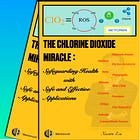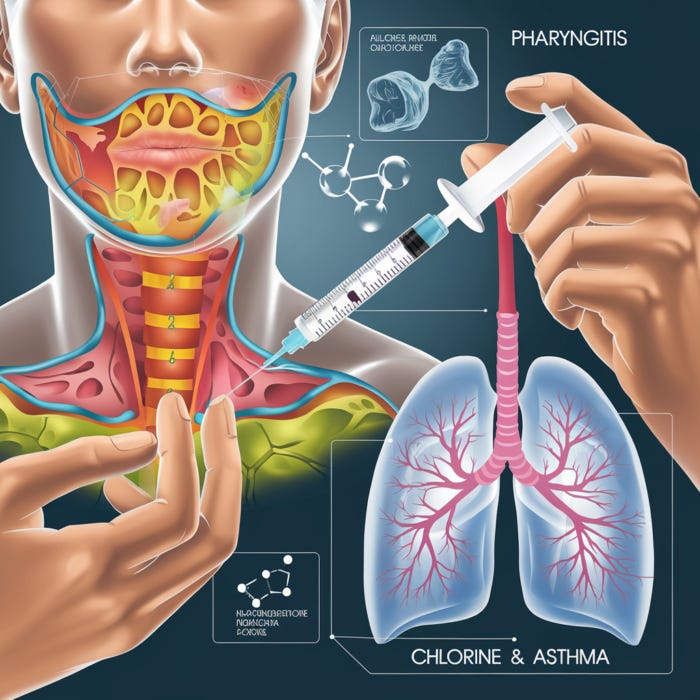This excerpt is from my book, "The Chlorine Dioxide Miracle: Safeguarding Health with Safe and Effective Applications." If you're interested in chlorine dioxide therapy, you can purchase the book here:
Although there is no evidence, I believe the same method can treat asthma.
9.1 Pharyngitis and Chlorine Dioxide
Chronic pharyngitis is a long-term inflammation of the mucous membrane of the pharynx and its underlying tissues. It can be caused by various factors, including persistent viral or bacterial infections, smoking, environmental pollutants, excessive use of the vocal cords (such as frequent loud speaking or singing), alcohol consumption, chronic sinusitis, or allergies. Additionally, gastroesophageal reflux disease (GERD) can cause stomach acids to reflux into the throat, causing or exacerbating chronic pharyngitis.
Symptoms of chronic pharyngitis include persistent throat discomfort, dryness, itchiness, or a sensation of a foreign body in the throat. Patients may frequently clear their throat or cough in an attempt to relieve these symptoms. Sometimes, they may feel mucus stuck in their throat, usually due to increased mucus production caused by inflammation. Sore throat, hoarseness or voice changes, and difficulty swallowing may also occur.
Diagnosis of chronic pharyngitis is typically based on symptoms and a clinical examination. A doctor may use a laryngoscope to inspect the throat. In some cases, further tests such as a throat swab culture, blood tests, or imaging studies may be necessary to rule out other potential conditions.
Current treatments for chronic pharyngitis focus on relieving symptoms and addressing the underlying cause. If an infection is responsible, antibiotics or antiviral medications may be required. For chronic pharyngitis caused by smoking or environmental factors, avoiding these irritants is crucial. Quitting smoking and limiting alcohol are vital for symptom relief. If chronic pharyngitis is related to GERD, doctors may recommend antacids or other treatments for gastroesophageal reflux.
Regarding my own limited experience with chronic pharyngitis, it was a long-standing issue for me until I began regular exposure to chlorine dioxide. Over time, as I continued to come into contact with chlorine dioxide daily, I gradually forgot about my pharyngitis, which seemed to heal unnoticed. Considering that chronic pharyngitis is essentially an inflammation, and chlorine dioxide has significant anti-inflammatory properties, I believe that chlorine dioxide can be effective in treating chronic pharyngitis.
9.2 Pharyngitis Treatment Protocol
A. Preparation of Chlorine Dioxide:
Weigh 100 grams of solid sodium chlorite (powder, purity 80%, with the remaining 20% being sodium chloride), and add 900 milliliters of deionized water (or distilled water). Heat the mixture to around 50 degrees Celsius, and once the solid is completely dissolved, allow it to cool to room temperature. This creates an 8% sodium chlorite solution.
Weigh 200 grams of solid citric acid (analytical grade, purity 99.9%), and add 800 milliliters of deionized water (or distilled water). Heat the mixture to around 50 degrees Celsius, and once the solid is completely dissolved, create a 20% citric acid solution.
Mix the two solutions in equal volumes and wait for approximately 5 minutes to prepare a saturated solution of acidic chlorine dioxide (approximately 3000 ppm, or 3 mg/mL).
B. Method of using chlorine dioxide for treating pharyngitis:
Place the prepared chlorine dioxide solution in front of the mouth, with the bottle opening facing the mouth or nose, open the mouth, breathe naturally, and allow the chlorine dioxide to come into contact with the throat through the mouth. Use this fumigation method to allow the chlorine dioxide to come into contact with the throat. Due to the strong irritant effect of chlorine dioxide on the mucous membranes, the fumigation process should not exceed 15 seconds, and should be stopped immediately if discomfort is felt. Repeat this fumigation process 1 to 2 times a day, and do not use it continuously for more than 2 days. It is important to avoid direct contact between the chlorine dioxide solution and the throat. Unlike the eyes, chlorine dioxide can cause a certain degree of damage to the throat, and this kind of damage generally takes 5-7 days to heal.






Just trying this now using an inhaler for pharyngitis. Timely advice , thanks.
Next time I will reduce the amount in the inhaler as it is a remarkably effective way of inhaling.
Having said that, so far so good. The Pharyngitis is non infectious, just a residual from a viral infection that has passed the four week mark and this method seems an effective way to bring the gas to the site and reducing the inflammation.
Just not too much at once !